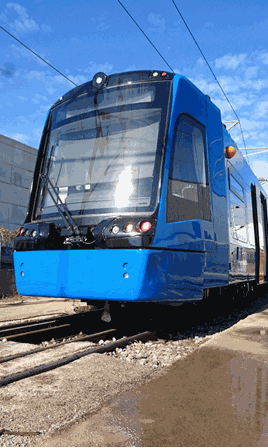Read part two of the Sheffield tram-train feature.
The answer comes so confidently, without hesitation, that it absolutely blindsides me. I might even have gasped, impolitely.
By this point, I’ve had two hours of being allowed to prod and poke around every aspect of Vossloh’s Citylink tram-train vehicle, and I’m as giddy as a ten-year-old on shed bunk.
The team have eagerly shared their insight into the design and development process. There are technical innovations galore awaiting the UK when the first of seven three-car vehicles finally reaches our shores - from the bogies to the running gear to, well, the whole thing, frankly.
So, “which aspect of the job are they most satisfied with?” No question. “The comfort of the seats.”
Are you sitting comfortably? Then we’ll begin. The Vossloh plant sits in several acres just north of Valencia, a stone’s throw from the Mediterranean frothing angrily at the sea wall. Like many companies, Vossloh can trace its roots back to the days when railways were first extending metals across their country. Recent expansion dictated moving to the current site in 1997, but history is not forgotten - a sizeable 2-8-2 steam locomotive is mounted opposite the main gate.
The greeting from the project team is warm - their hospitality is the first sign of the enthusiasm for the work that is under way here. And these are busy times, with new sheds being built on site.
The company is currently working on a dozen projects for various clients, three of them for the UK market. Having not so long ago worked on the Class 67 locomotives, Vossloh is now building the Class 68, the ‘88’ and the tram-train pilot vehicles. As we drive around to the test track, negotiating lines of new locomotives, some ‘68s’ are given away by their distinctive bulbous noses.
We arrive at a locked gate. “It will be here in a minute,” says one of the team. Sure enough, with a hoot any native of Sheffield might already find familiar, the UK’s first tram-train glides around a corner towards us, smoothly and silently.
First impressions count. In the sun it looks sleek and modern, already wearing the Stagecoach Supertram livery of deep blue, albeit without decals. (Later, as I have to lean on the bodywork to take pictures, it’s not without feeling guilty). Tantalisingly, the top panels have yet to be installed, revealing running gear that will be hidden once in service. It’s a natural place to start.
Between Network Rail, Stagecoach (which operates Supertram) and the South Yorkshire Passenger Transport Executive, the decision has been taken to opt for an entirely electric system, using a dual voltage - 750V DC in tram mode and the standard 25KV AC when running out onto the main line. As it crosses from the tram network to the heavy rail lines, the vehicle will pass through a ‘neutral zone’ where it will automatically switch modes.
Next to the pantograph is the equipment that will regulate the voltage sent down to the powered bogies. There are three of these (with another bogie being just a trailer), which is one more than on the vehicles Vossloh built for the tram-train network in the German town of Karlsruhe. The city of seven hills, Sheffield will require trams with a bit more oomph for the gradients!
The compressor is also up here, which provides air for the suspension. Placing the equipment up here gives the vehicle a door access height of just 425mm, which in turn means platform height is a mere 375mm.
Unlike the other early UK tram revival in Manchester, Supertram didn’t take over an existing urban commuter line. Instead, it mixes far more street running with newly built formation. The decision was taken at the time to provide low platforms throughout the network, which means station stops feel like extensions of the existing pavement.
The team are quick to point out that the new vehicle has self-levelling suspension. No matter the load, the vehicle platform will always be at this height - part of a commitment to barrier-free access for people who use wheelchairs, or who have children in buggies. This means innovative bogie design, too, again capitalising on the lessons from Karlsruhe.
It is apparently the low platforms that brought the tram-train pilot to South Yorkshire. This was the model that the authorities wanted to test.
The £240 million Supertram network currently covers some 18 miles, operating 25 German-built trams. The entire system (broadly speaking three lines, which converge in Sheffield city centre) was finally completed in October 1995. Tram-train is its first extension, and will (for the first time) take it outside of Sheffield, to Rotherham. This itself represents an investment of more than £50m.
Tram-train vehicles will leave their traditional network close to Meadowhall and cross onto a heavy rail line currently used by occasional freight trains. A connecting spur needs to be constructed, and the heavy rail route electrified.
From there, the vehicles will be able to reach Rotherham Central, where a low extension to the platform will be built. The ultimate terminus is some two miles further on, at the Parkgate Retail Park, where another spur will give Tram-Train its own station off the main line.
Experience in Germany comes up often during the tour, and it soon becomes clear that this is the touchstone for the UK pilot, not a blueprint. Indeed, soon after my visit, one of the customers (the South Yorkshire Passenger Transport Executive) praises Vossloh for its flexibility. It hasn’t sold an off-the-shelf product to the UK, but developed a bespoke solution. Combining technology and satisfying the regulations of a country with no experience of Tram-Train means innovation has been an ever-present partner. Inside and outside crash protection has been factored with subtlety, yet certainty.
Jorge Vara is Development Manager for Vossloh’s ‘Citylink’ family of vehicles. He joined the company as a student and has been here for 17 years. As we talk, his passion is obvious.
“Tram-train is good. It’s a mix of two systems in one. It provides the best of both systems - short braking distance, higher speed, barrier-free , big windows, the comfort of a train. So you are blending two well-known, well-running systems into one - that’s the benefit. It has been a challenge, it has been tough, but it is always exciting. We’re not such a big company, and we’re working close to the customer, face-to-face, day-to-day. So it’s working, working, working.”














Comment as guest
Comments
No comments have been made yet.